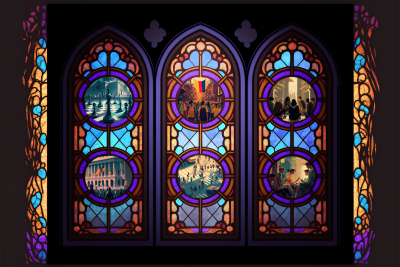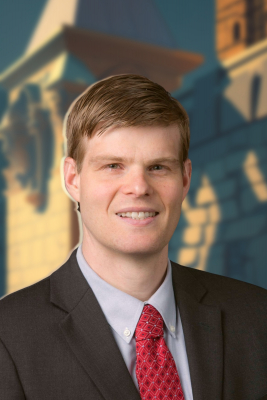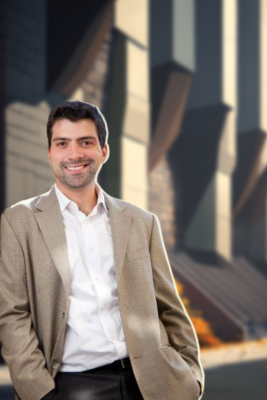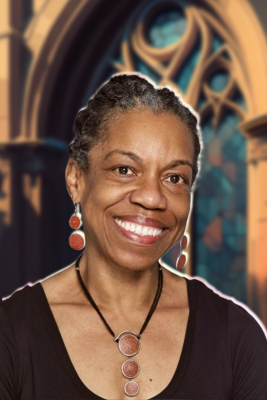How Did Political Polarization Begin, and Where Does it End?
Written by Shaun King, Trinity Communications

Image courtesy of Shaun King / Trinity Communications
January 26, 2023: The racial healing section of this story was updated with additional information.
“By connecting people and giving them a voice, social media had become a global force for plurality, democracy and progress,” The Economist wrote of the early 2010s.
At the time, families were connecting across continents, small businesses were growing their audiences and niche communities were crowdsourcing knowledge. Then Facebook and Twitter helped mobilize democratic protests strong enough to bring down long-standing regimes during the Arab Spring.
But one after another, scandals erupted, from Cambridge Analytica in 2018 to Donald Trump’s suspension from major social media platforms after the January 6 mob attack on the U.S. Capitol.

"This is a landmark decision,” Christopher Bail, professor of Sociology, said on CNN the day the Oversight Board, an independent body created to review decisions about free expression on Facebook, ratified the company’s decision to ban Trump. “This is certainly not the end of the story. We were polarized long before Donald Trump, and we will be polarized long after.”
Not long after, in fact, Elon Musk purchased Twitter and proposed reinstating Trump there. The decision caused celebration from some and outcry from others, raising questions about free expression and “deplatforming” that could also be described as debates about the boundaries of tolerance in the face of deep polarization.
The problems that cause division go much deeper than specific policy decisions. As the fragility of political norms and the intensity of entrenchment become ever more pressing issues, a number of Duke professors are exploring how we got here. If we were polarized long before the 2016 election, their work offers not just an essential history, but a path forward.
Legitimate opposition
“One of the most ancient ideas in Western thought is that rational deliberation will produce better societies,” Bail writes in his book “Breaking the Social Media Prism.”
The belief in deliberation’s value dates back at least as far as Plato, but took on particular momentum with the widespread readership of John Stuart Mill’s 1859 essay “On Liberty.” Lauding diversity of opinion because “it is only by the collision of adverse opinion that the remainder of truth has any chance of being supplied,” Mill was deeply optimistic about truth’s ability to surface on its own.
His appreciation for viewpoint diversity foregrounded what later became known as the “marketplace of ideas.” In the 20th century, so-called “deliberative democracy” theorists expanded on that notion, defining idealized processes for democratic decision-making that would create either truth or virtue, or at least autonomous experiences of self-governance.
“It is not surprising, then,” Bail notes, “that early observers of the internet celebrated the potential of social media to scale up salon culture, creating a massive and open marketplace of ideas.”
Those hopes were disappointed. Bail points to volumes of social science research indicating that our desire for rational, dispassionate deliberation, as well as our ability to empathize, is limited and shaped by our political identities. In a recent experiment, Bail and his team recruited a large sample of Republicans and Democrats and exposed each group to viewpoints from the other. The results were so worrying that the team thought they may have made a coding error.
Perhaps no event tested the boundaries of tolerance – and the role of social media – as much as the January 6, 2021, assault on the Capitol, after which the FBI charged more than 900 people with federal crimes.
“In the months after the 2020 presidential election, Americans were exposed to the dread and bitter anxiety of an unsuccessful political transition, of the failure of legitimate opposition,” Alexander Kirshner, associate professor of Political Science, wrote about those events in his new book, “Legitimate Opposition.”

Legitimate opposition is an approach to politics that emphasizes the adversarial nature of political life rather than its more idealized cooperative side. It sees deep policy disagreements and unequal outcomes as allowable if — and only if — the opposition can change those outcomes through the peaceful exchange of power.
Driven by the question of what is lost when a flawed, real-world political entity undermines legitimate opposition, Kirshner’s research takes into account Bail’s concern about our limits as rational political cooperators. The political scientist explains that we cannot establish the justification for legitimate opposition on the foundation of an ideal theory, like the marketplace of freely exchanged ideas: Political opposition between groups is inevitably messy, and some limited misinformation and lies are inherent in its practice.
By adopting that approach, Kirshner rejects a prevailing theory among social scientists that views any practice of democracy in which power is transferred through competitive elections as legitimate because, by that definition, the slavery-era United States was a functioning democracy.
Instead, Kirshner argues that by separating the practice of legitimate opposition from the practice of democratic institutions, we can better realize the value of both. The mob assault on the Capitol was not only an attack to stop the democratic election but also a violation of the legitimacy of opposition in general.
Even though this conception may produce systems that are unfair and unequal, opposition that is seen as legitimate “instantiates a valuable form of respect for the agency of those who participate,” Kirshner says. Opposition does not necessarily guarantee a liberal society or outcomes, “but opposition’s procedures necessarily treat people as actors, as coauthors of political life.”
A history of tolerance
At root, the question of how members of a society can deliberate and oppose one another is a question of how much disagreement they can tolerate. And that may be why the concept of tolerance has long been central to the liberal political tradition.
It’s ironic, then, that the concept of tolerance emerges not in the ancient Greek democratic tradition, but in the writings of Cyprian, a North African bishop from 250 CE who was primarily responding to the letters of Paul the Apostle.

Tracing that history in an in-progress manuscript, Jed Atkins, E. Blake Byrne Associate Professor of Classical Studies, argues that the building blocks of tolerance are spread out across the collection of texts that became known as the New Testament. Because God is defined by the capacity for judgment, early Christians believed they should refrain from judging each other. They emphasized patience as a way of leaving judgment to God and leaving room for restitution and forgiveness.
Patience then emerges as a virtue, and Cyprian develops the concept of tolerance as the practice of patience. The language was particularly useful at a time when Christianity lacked unity and political power. But a century later, scriptures were canonized and questions of orthodoxy became the new test of tolerance.
Atkins points to a sect called the Donatists who saw the world in binary terms: There was a pure, idealized church and the “traditores,” or Christian traitors who corrupt. In response to the Donatists, Augustine of Hippo positions justice, not patience, as the organizing principle defining what is tolerable — a framework that has been expanded through various Christian traditions since.
Over the last two hundred years, as the Western world secularized, toleration was increasingly justified by the need to avoid harm and create neutrality, which is the absence of judgement. Atkins describes how tolerance shifts toward a connection with respect, seen most vividly in the changes in the writings of political philosopher John Rawls.
After committing to the view that rights are universal because of their connection to a common creator, Rawls updated the notion in later works to claim that individual rights are owed out of a respect born from our capacity for moral agency. As Rawls became a centerpiece of the last century’s secular political foundation, the concept of tolerance increasingly took on its current meaning as dignity-oriented respect.
How to forgive
In highly polarized societies, the success of forgiveness may be an important indicator of the success of tolerance, and Felipe De Brigard, Fuchsberg-Levine Family Associate Professor of Philosophy and Psychology & Neuroscience, looks to the ending of the multigenerational civil conflict in Colombia as a case study.

De Brigard’s research focuses on how our autobiographical memories, at least those we can recall episodically, interact when we consider them against imagined, alternative ways in which the remembered events could have occurred. Newly imagined counterfactual events that did not happen can reshape our relationship to the actual historical events, De Brigard finds.
He calls this an “emotional reappraisal strategy.” When we reactivate negative memories, our typical response is to imagine how the event could have been better, and that brings about regret. Instead, a “downward counterfactual” is one where we purposefully imagine how the event could have been worse.
“That usually brings about a feeling of relief at the time of imagining, and that sometimes modifies our memory a little bit,” says De Brigard.
The pilot data that De Brigard has collected during his ongoing research in Colombia so far indicates that to forgive does not mean a change in judgment about the event, De Brigard says, but to emotionally reappraise our memory of the wrongdoing. That kind of forgiveness is especially important in the north of Colombia, where horrendous acts of civil war occurred.
“Now, many of the perpetrators of those same actions are moving back into the same villages in which their victims live,” says De Brigard.
He believes truth plays an important role in how emotional reappraisal works in extremely polarized communities. In the Truth Commission from Colombia’s 2016 FARC Peace Accord, members collected research from decades of conflict and interviews with nearly 24,000 people across the country. De Brigard notes that people from all sides spread misinformation to make the other side look worse.
The unveiling of truth through the commission helped foster introspection about how emotions were manipulated. At the same time, De Brigard’s research team guided another process in which those same emotional events were channeled productively toward healing and forgiveness.
Because truth fills holes in stories and resolves contradictions, pursuing it is a sign of care. “Truth has a healing component,” De Brigard says. “It structures a narrative that helps us make sense of what happened.”
Racial healing
The national Truth, Racial Healing & Transformation (TRHT) movement was launched in 2016 as a comprehensive, holistic, community-based process to bring about sustainable change regarding racism. It is informed by various successful international truth and reconciliation commissions that have produced reports on human rights violations and civil wars, like Colombia’s.
TRHT prioritizes transformation rather than reconciliation because the latter conveys "bringing together again after conflict," according to TRHT. "The United States was never together in the first place," says Charmaine Royal, the Robert O. Keohane Professor of African & African American Studies and Biology and director of the Duke Center for Truth, Racial Healing & Transformation.
Shifting to transformation means acknowledging that the Constitution was built on the premise of a racial hierarchy and a “collective national consciousness” that has divided group access and outcomes for centuries.
In 2017, TRHT expanded to include Campus Centers hosted by the American Association of Colleges & Universities. There are now more than 70, and Duke’s was among the first 10.

One of the core components of the TRHT framework and one of the Duke TRHT Center's signature engagement strategies is the Rx Racial Healing Circle. “This is not a conversation about race,” Royal says. “Cofacilitated by two trained racial healing practitioners, these circles provide an opportunity for a diverse group of people to come together and listen to and share authentic stories about their lives. This relational experience fosters empathy, encourages perspective-taking, and affirms our common humanity.”
In other words, the events are designed celebrate what unites us rather than accentuating what divides us.
“Tailored and positive prompts are used to give participants a sense of agency and affirm basic motivational human needs, such as a sense of security or self-expression,” says Royal, whose scholarship is in the fields of genetics and genomics with a focus on the ethical, social, scientific and clinical implications.
Rx Racial Healing Circles — and the TRHT process as a whole — help challenge the primary fallacy Royal’s academic work targets, which she describes succinctly as the idea “that human biological races exist and are ranked hierarchically.”
The Duke TRHT Center offers their events to staff, students, faculty, administrators, alumni and community members both in and outside of Duke. Additional programing includes “Transforming Dialogues on Race and Racism,” which aim to cultivate a critical personal evaluation of the lived impacts of racism; UNESCO Story Circles, which develop intercultural competencies; and a workshop on incorporating the TRHT framework into other racial justice work.
But how could we know if the center's approach is working? “We want to first create an evidence base for Rx Racial Healing Circles,” Royal says, which is why Duke TRHT Center researchers and collaborators are studying the impact of their programming with support from Bass Connections.
Intellectual humility
Watching events unfold on January 6, then a U.S. president getting removed from social media platforms for his role in them, it can be hard to imagine facilitated dialogue could help. But one of Bail’s primary findings shows reason to hope.
“Surprisingly, few people are actually in political echo chambers,” he says. “The bigger problem is the growing gap between social media and reality. Right now, 73% of tweets about politics are generated by just 6% of Twitter users, and that 6% has very extreme views. This makes all of us feel much more polarized than we really are.”
Social media is not a mirror that reflects us but a prism that distorts us, Bail explains.
Through the Duke Polarization Lab, Bail; Sunshine Hillygus, professor of Political Science and Public Policy; Alexander Volfovsky, professor of Statistical Science and Computer Science; and their graduate students are taking deliberate action to address it.
The first big step forward was producing plugins and middleware that encourage users to explore the reality-distorting nature of online trends and conversation threads. Examples include a 3D visualization of the ideological distance between various political leaders and groups, a troll-o-meter that helps predict whether someone’s goal is to antagonize and a bipartisanship leaderboard that sorts leaders and groups based on how well they appeal to both sides of issues.
Now, the lab is taking another step with a Templeton Foundation-funded social media research platform. The Lab will recruit more than 5,000 users to design tools that incentivize “intellectual humility” in user behavior.
It sounds lofty, but the research team has a realistic appraisal of the minority of users who pursue micro-celebrity. Those people are, Bail says, “addicted to the positive social feedback loop created by engagement-based newsfeed ranking.” Engineering incentives is not for them; it’s for their silent audience.
With Meta’s stock spiraling, Elon Musk’s volatile leadership of Twitter and a growing awareness of polarization as a pressing problem, now might be the time. Paired with a more detailed understanding of the role of opposition in politics, the intellectual history of tolerance, the neuroscience of forgiveness, and successful racial healing programs, there might even be reason for optimism.
